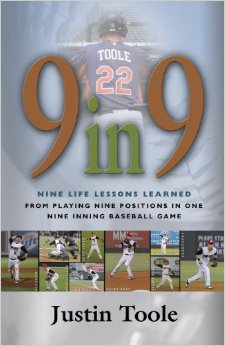 Indians Archive
Indians Archive  Book Review: 9 in 9 by Justin Toole
Book Review: 9 in 9 by Justin Toole
 Justin Toole comes from a baseball family. His dad coached his teams growing up, and his brother Eric just wrapped his sophomore season as a 2nd-team All-Big Ten outfielder for the Iowa Hawkeyes. His sister was a softball player. Watching Toole play the game, it’s easy to see the influence that his baseball-oriented upbringing has had on his career as a player. Toole can play any position on the diamond (literally), and always knows what to do with the baseball anytime it is hit to him. He’s a patient hitter at the dish, and is sneaky-effective on the basepaths. He’s not a burner, but reads balls well in dirt and goes first-to-third quicker than some players with better raw speed. In short, he does all of the little things well, helping his overall package play greater than the sum of his tools.
Justin Toole comes from a baseball family. His dad coached his teams growing up, and his brother Eric just wrapped his sophomore season as a 2nd-team All-Big Ten outfielder for the Iowa Hawkeyes. His sister was a softball player. Watching Toole play the game, it’s easy to see the influence that his baseball-oriented upbringing has had on his career as a player. Toole can play any position on the diamond (literally), and always knows what to do with the baseball anytime it is hit to him. He’s a patient hitter at the dish, and is sneaky-effective on the basepaths. He’s not a burner, but reads balls well in dirt and goes first-to-third quicker than some players with better raw speed. In short, he does all of the little things well, helping his overall package play greater than the sum of his tools.
Toole isn’t a guy who is going to go out and hit 40 HR in a season. His strengths lie in his versatility and fundamentally sound play. A long shot to be an everyday player in a major league lineup, the former undrafted free agent is a career .247/.298/.293 hitter in 361 minor league games. He’s appeared in 118 games at 2B, 54 games at SS, 53 games at 1B, 90 games at 3B, 36 games in the OF, 2 games on the mound and one game behind the plate. He has played at nearly every level in the Indians system, from rookie AZL to AAA Columbus, with stops in Mahoning Valley, Kinston/Carolina, and Akron. Anytime Toole is needed anywhere in the system, he answers the call and fills the organizational need. When you’re around a team that Toole plays on, it’s easy to see the effect he has in the clubhouse. Everyone from the other players, the manager and coaching staff to the team’s announcer talks about the impact Toole has on and off the field, and that is something that just can’t be captured in a box score.
 Toole made headlines around the country last year when he played all nine defensive positions in a single nine-inning game for the Mudcats. He started the game in RF and moved all the way around the diamond throughout the contest before pitching the bottom of the 9th in a 4-2 Mudcats victory. Pitching was hardly foreign to Toole, who was the Bob Feller Award winner as the top high school pitcher in the state of Iowa his senior year. It was a unique experience for the versatile utility infielder, one that gave him a chance to reflect on the lessons he’s been able to learn throughout his baseball life.
Toole made headlines around the country last year when he played all nine defensive positions in a single nine-inning game for the Mudcats. He started the game in RF and moved all the way around the diamond throughout the contest before pitching the bottom of the 9th in a 4-2 Mudcats victory. Pitching was hardly foreign to Toole, who was the Bob Feller Award winner as the top high school pitcher in the state of Iowa his senior year. It was a unique experience for the versatile utility infielder, one that gave him a chance to reflect on the lessons he’s been able to learn throughout his baseball life.
Toole was a psychology major at Iowa, and uses some of the lessons he learned in sports psychology classes to coach young players in various camps during the offseason. In addition to the coaching, Toole has written a book based on his famous nine positions in nine innings game, and that book is now available via Amazon. I got my copy this week, and it’s an excellent read. In the book, Toole relates how the nine positions he played for the Mudcats that night relate to nine different life lessons that can be applied to the mental side of baseball. This ties in nicely with a recent article from Baseball Prospectus/Grantland columnist Ben Lindbergh, who recently completed MLB’s certified Scout School. Lindbergh is talking to a veteran scout about the mental side of the game, and the veteran scout tells him the following:
According to Larson, 90 percent of prospects fail to reach their OFPs (overall future potential). Most often, he says, it’s because of intangibles. It’s much more common for a player’s makeup to prevent him from making the majors than for it to propel him there. My guess is that assessing makeup will become an increasingly important part of scouts’ responsibilities as PITCHf/x, biomechanical analysis, and other applications of motion-tracking tech permeate the lower levels of the minors and bleed into amateur ball. Watching a player work and collecting character references isn’t something a computer can do, although refinements in psychological testing — not a new concept in baseball, but an increasingly popular one — may eventually offer an automated alternative.
From spending as much time around Toole as I have, I know he’ll never have a problem with the mental side of the game. His tools will always play up to their overall future potential (OFP), because he’s head and shoulders over the vast majority of his counterparts when it comes to the psychology of the game. He’s always a pleasure to talk to, and even though I’ve played and studied the game all of my life, I always learn something new about baseball whenever I have the pleasure of talking to him.
The book has nine chapters, each of which first recaps one inning of action at a different position and then explains how to apply that inning to life both in and outside of baseball. Toole teaches the reader about patience, perspective, expensive/inexpensive experience, taking advantage of your opportunities, hard work beating talent when talent doesn’t work, believing in yourself, controlling what you can control, being comfortable when uncomfortable, and staying in the moment. He talks not just about the 9-in-9 game, but about his high school career, collegiate ball, and lessons learned on the road to playing professional baseball. His was not an easy road to becoming a pro, as he had to fight for his spot on the Iowa baseball roster, then had a quick stint in independent ball (after breaking his arm in a late-season game against Michigan State) before being signed as an undrafted free agent by the Indians. He was almost drafted in the 27th round by the Marlins, but was too honest with one of their scouts (see chapter one). He always had to outwork his competition, because he wasn’t always the most talented player on the field, court or gridiron.
 I highly recommend the book for baseball players or coaches at any level of the game, from little league all the way up to college and the pros. If I were a high school coach, I’d make it required reading for all of my players. When I have kids, I’m going to make them read it. It contains tips on how to play each position, mental keys to the game and provides a fantastic insight into the road to becoming a major league baseball player. The vast majority of baseball players don’t get to take the Bryce Harper or Steven Strasburg route, playing just a season or so of minor league ball before being promoted to the bigs. Most play several seasons in the minors before making it to The Show, and more players top out in the minors than actually make it to the big leagues. It’s a side of the game that very few fans ever get to learn about, and it’s really interesting to hear some of the trials and tribulations of a player working his way from high school through college and the minor leagues. Toole hasn’t had the easiest road as he works his way to the big leagues, but he’s learned a lot more about the game and about himself than some of the bonus babies who have been handed millions of dollars straight out of high school. He knows how to handle adversity, and has become a more well-rounded player and person because of it.
I highly recommend the book for baseball players or coaches at any level of the game, from little league all the way up to college and the pros. If I were a high school coach, I’d make it required reading for all of my players. When I have kids, I’m going to make them read it. It contains tips on how to play each position, mental keys to the game and provides a fantastic insight into the road to becoming a major league baseball player. The vast majority of baseball players don’t get to take the Bryce Harper or Steven Strasburg route, playing just a season or so of minor league ball before being promoted to the bigs. Most play several seasons in the minors before making it to The Show, and more players top out in the minors than actually make it to the big leagues. It’s a side of the game that very few fans ever get to learn about, and it’s really interesting to hear some of the trials and tribulations of a player working his way from high school through college and the minor leagues. Toole hasn’t had the easiest road as he works his way to the big leagues, but he’s learned a lot more about the game and about himself than some of the bonus babies who have been handed millions of dollars straight out of high school. He knows how to handle adversity, and has become a more well-rounded player and person because of it.
In the game itself, Toole went 1-4 with a single at the plate, and gave up 2 runs on 2 hits (both solo HR) on the mound…but after the back-to-back solo HR, Toole came back with back-to-back strikeouts to preserve a 4-2 Mudcat victory. The pitching inning (and 9th and final chapter of the book) is my favorite. It includes a couple of funny stories relating to the Mudcat bullpen on and off the field, and it serves as a microcosm for Toole’s entire sports career. He faces a new challenge, encounters adversity, and overcomes to find success. Toole is never going to be the anchor of the Indians lineup at the major league level, but there’s a chance he finds some measure of success as a utility player. Even if he never plays a single major league inning, I am 100% confident that Justin Toole will be successful in life, no matter what career he pursues after baseball. He could be an outstanding coach, trainer or sports psychologist. He could be a great accountant, lawyer, stock trader or whatever he decides to do. He’s one of my favorite players in the organization, and I can’t wait to see him play next season.
- NBA Announces 2013-2014 Schedule
- Browns Ink Sharknado
- Sharknado A No-Show For Rookie Camp
- Trent Richardson Out Until Training Camp
- Browns Sign Brandon Jackson
- Carrasco Suspended Eight Games
- Browns Add to Wide Receiver Depth with David Nelson
- Browns Need to Learn from Past Draft Mistakes
- Browns Release Chris Gocong and Usama Young
- Browns Missing on Grimes Disappointing, But Not The End
The TCF Forums
- Chris Grant's first 3 drafts
Kingpin74 (Tuesday, January 21 2014 10:13 AM) - The 2014 Offseason Thread
googleeph2 (Tuesday, January 21 2014 9:36 AM) - 2015 Recruiting
furls (Tuesday, January 21 2014 6:57 AM) - Mike Brown
YahooFanChicago (Monday, January 20 2014 11:15 PM) - Movies coming out
HoodooMan (Monday, January 20 2014 9:34 PM) - 2014 Hoops Hockey Hijinx
jpd1224 (Monday, January 20 2014 4:44 PM) - 2014 Recruiting
jclvd_23 (Monday, January 20 2014 2:26 PM) - Wish List - #4 Pick
Hikohadon (Monday, January 20 2014 1:26 PM) - Official- Browns Coach Search/Rumors
OldDawg (Sunday, January 19 2014 6:48 PM) - #1 overall pick Anthony Bennett
TouchEmAllTime (Sunday, January 19 2014 1:28 PM)


